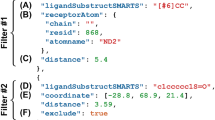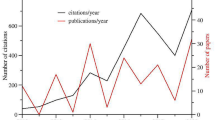Abstract
We continued prospective assessments of the Wilma–solvated interaction energy (SIE) platform for pose prediction, binding affinity prediction, and virtual screening on the challenging SAMPL4 data sets including the HIV-integrase inhibitor and two host–guest systems. New features of the docking algorithm and scoring function are tested here prospectively for the first time. Wilma–SIE provides good correlations with actual binding affinities over a wide range of binding affinities that includes strong binders as in the case of SAMPL4 host–guest systems. Absolute binding affinities are also reproduced with appropriate training of the scoring function on available data sets or from comparative estimation of the change in target’s vibrational entropy. Even when binding modes are known, SIE predictions lack correlation with experimental affinities within dynamic ranges below 2 kcal/mol as in the case of HIV-integrase ligands, but they correctly signaled the narrowness of the dynamic range. Using a common protein structure for all ligands can reduce the noise, while incorporating a more sophisticated solvation treatment improves absolute predictions. The HIV-integrase virtual screening data set consists of promiscuous weak binders with relatively high flexibility and thus it falls outside of the applicability domain of the Wilma–SIE docking platform. Despite these difficulties, unbiased docking around three known binding sites of the enzyme resulted in over a third of ligands being docked within 2 Å from their actual poses and over half of the ligands docked in the correct site, leading to better-than-random virtual screening results.





Similar content being viewed by others
References
Reddy MR, Erion MD (2001) Free energy calculations in rational drug design. Springer, Berlin
Chodera JD, Mobley DL, Shirts MR, Dixon RW, Branson K, Pande VS (2011) Alchemical free energy methods for drug discovery: progress and challenges. Curr Opin Struct Biol 21:150–160
Gohlke H, Klebe G (2002) Approaches to the description and prediction of the binding affinity of small-molecule ligands to macromolecular receptors. Angew Chem Int Ed 41:2644–2676
Gilson MK, Zhou HX (2007) Calculation of protein–ligand binding affinities. Annu Rev Biophys Biomol Struct 36:21–42
Ferrara P, Gohlke H, Price DJ, Klebe G, Brooks CL III (2004) Assessing scoring functions for protein–ligand interactions. J Med Chem 47:3032–3047
Wang R, Lu Y, Fang X, Wang S (2004) An extensive test of 14 scoring functions using the pdbbind refined set of 800 protein–ligand complexes. J Chem Inf Comput Sci 44:2114–2125
Warren GL, Andrews CW, Capelli AM, Clarke B, LaLonde J, Lambert MH, Lindvall M, Nevins N, Semus SF, Senger S, Tedesco G, Wall ID, Woolven JM, Peishoff CE, Head MS (2006) A critical assessment of docking programs and scoring functions. J Med Chem 49:5912–5931
Moitessier N, Englebienne P, Lee D, Lawandi J, Corbeil CR (2008) Towards the development of universal, fast and highly accurate docking/scoring methods: a long way to go. Br J Pharmacol 153:S7–S26
Englebienne P, Moitessier N (2009) Docking ligands into flexible and solvated macromolecules. 4. Are popular scoring functions accurate for this class of proteins? J Chem Inf Model 49:1568–1580
Purisima EO, Hogues H (2012) Protein–ligand binding free energies from exhaustive docking. J Phys Chem B 116:6872–6879
Chen W, Gilson MK, Webb SP, Potter MJ (2010) Modeling protein–ligand binding by mining minima. J Chem Theory Comput 6:3540–3557
Kollman PA, Massova I, Reyes C, Kuhn B, Huo S, Chong L, Lee M, Lee T, Duan Y, Wang W, Donini O, Cieplak P, Srinivasan J, Case DA, Cheatham TE (2000) Calculating structures and free energies of complex molecules: combining molecular mechanics and continuum models. Acc Chem Res 33:889–897
Gohlke H, Case DA (2004) Converging free energy estimates: MM-PB(GB)SA studies on the protein–protein complex Ras–Raf. J Comput Chem 25:238–250
Brown SP, Muchmore SW (2009) Large-scale application of high-throughput molecular mechanics with Poisson–Boltzmann surface area for routine physics-based scoring of protein–ligand complexes. J Med Chem 52:3159–3165
Naim M, Bhat S, Rankin KN, Dennis S, Chowdhury SF, Siddiqi I, Drabik P, Sulea T, Bayly CI, Jakalian A, Purisima EO (2007) Solvated interaction energy (SIE) for scoring protein–ligand binding affinities. 1. Exploring the parameter space. J Chem Inf Model 47:122–133
Cui Q, Sulea T, Schrag JD, Munger C, Hung MN, Naim M, Cygler M, Purisima EO (2008) Molecular dynamics—solvated interaction energy studies of protein–protein interactions: the MP1-p14 scaffolding complex. J Mol Biol 379:787–802
Sulea T, Purisima EO (2012) The solvated interaction energy method for scoring binding affinities. Methods Mol Biol 819:295–303
Sulea T, Cui Q, Purisima EO (2011) Solvated interaction energy (SIE) for scoring protein–ligand binding affinities. 2. Benchmark in the CSAR-2010 scoring exercise. J Chem Inf Model 51:2066–2081
Skillman G. SAMPL1 at first glance. Cup IX meeting, Santa Fe, NM, 19 March 2008. http://eyesopen.com/2008_cup_presentations/CUP9_Skillman.pdf. Accessed 10 Jan 2014
Sulea T, Hogues H, Purisima EO (2012) Exhaustive search and solvated interaction energy (SIE) for virtual screening and affinity prediction. J Comput-Aided Mol Des 26:617–633
Dunbar JB, Smith RD, Yang C-Y, Ung PM-U, Lexa KW, Khazanov NA, Stuckey JA, Wang S, Carlson HA (2011) CSAR benchmark exercise of 2010: selection of the protein–ligand complexes. J Chem Inf Model 51:2036–2046
Cornell WD, Cieplak P, Bayly CI, Gould IR, Merz KM, Ferguson DM, Spellmeyer DC, Fox T, Caldwell JW, Kollman PA (1995) A second generation force field for the simulation of proteins, nucleic acids, and organic molecules. J Am Chem Soc 117:5179–5197
Case DA, Cheatham TE, Darden T, Gohlke H, Luo R, Merz KM, Onufriev A, Simmerling C, Wang B, Woods RJ (2005) The Amber biomolecular simulation programs. J Comput Chem 26:1668–1688
Wang J, Wolf RM, Caldwell JW, Kollman PA, Case DA (2004) Development and testing of a general Amber force field. J Comput Chem 25:1157–1174
Purisima EO (1998) Fast summation boundary element method for calculating solvation free energies of macromolecules. J Comput Chem 19:1494–1504
Purisima EO, Nilar SH (1995) A simple yet accurate boundary element method for continuum dielectric calculations. J Comput Chem 16:681–689
Chan SL, Purisima EO (1998) Molecular surface generation using marching tetrahedra. J Comput Chem 19:1268–1277
Chan SL, Purisima EO (1998) A new tetrahedral tesselation scheme for isosurface generation. Comput Graph 22:83–90
Bhat S, Purisima EO (2006) Molecular surface generation using a variable-radius solvent probe. Proteins 62:244–261
Jakalian A, Jack DB, Bayly CI (2002) Fast, efficient generation of high-quality atomic charges. AM1-BCC model: II. Parameterization and validation. J Comput Chem 23:1623–1641
Jakalian A, Bush BL, Jack DB, Bayly CI (2000) Fast, efficient generation of high-quality atomic charges. AM1-BCC model: I. Method. J Comput Chem 21:132–146
Chang CE, Gilson MK (2004) Free energy, entropy, and induced fit in host–guest recognition: calculations with the second-generation mining minima algorithm. J Am Chem Soc 126:13156–13164
Chen W, Chang CE, Gilson MK (2004) Calculation of cyclodextrin binding affinities: energy, entropy, and implications for drug design. Biophys J 87:3035–3049
Corbeil CR, Sulea T, Purisima EO (2010) Rapid prediction of solvation free energy. 2. The first-shell hydration (FiSH) continuum model. J Chem Theory Comput 6:1622–1637
Purisima EO, Corbeil CR, Sulea T (2010) Rapid prediction of solvation free energy. 3. Application to the SAMPL2 challenge. J Comput-Aided Mol Des 24:373–383
Ma D, Zavalij PY, Isaacs L (2010) Acyclic cucurbit[n]uril congeners are high affinity hosts. J Org Chem 75:4786–4795
McQuarrie DA (1976) Statistical mechanics. Harper & Row, New York
Gibb CL, Gibb BC (2004) Well-defined, organic nanoenvironments in water: the hydrophobic effect drives a capsular assembly. J Am Chem Soc 126:11408–11409
Sun H, Gibb CL, Gibb BC (2008) Calorimetric analysis of the 1:1 complexes formed between a water-soluble deep-cavity cavitand, and cyclic and acyclic carboxylic acids. Supramol Chem 20:141–147
Moghaddam S, Yang C, Rekharsky M, Ko YH, Kim K, Inoue Y, Gilson MK (2011) New ultrahigh affinity host–guest complexes of cucurbit[7]uril with bicyclo[2.2.2]octane and adamantane guests: thermodynamic analysis and evaluation of M2 affinity calculations. J Am Chem Soc 133:3570–3581
Moghaddam S, Inoue Y, Gilson MK (2009) Host–guest complexes with protein–ligand-like affinities: computational analysis and design. J Am Chem Soc 131:4012–4021
Gilson MK, Irikura KK (2010) Symmetry numbers for rigid, flexible, and fluxional molecules: theory and applications. J Phys Chem B 114:16304–16317
Gilson MK, Irikura KK (2013) Correction to “Symmetry numbers for rigid, flexible, and fluxional molecules: theory and applications”. J Phys Chem B 117:3061
Peat TS, Rhodes DI, Vandegraaff N, Le G, Smith JA, Clark LJ, Jones ED, Coates JA, Thienthong N, Newman J, Dolezal O, Mulder R, Ryan JH, Savage GP, Francis CL, Deadman JJ (2012) Small molecule inhibitors of the LEDGF site of human immunodeficiency virus integrase identified by fragment screening and structure based design. PLoS ONE 7:e40147
Rhodes DI, Peat TS, Vandegraaff N, Jeevarajah D, Le G, Jones ED, Smith JA, Coates JA, Winfield LJ, Thienthong N, Newman J, Lucent D, Ryan JH, Savage GP, Francis CL, Deadman JJ (2011) Structural basis for a new mechanism of inhibition of HIV-1 integrase identified by fragment screening and structure-based design. Antivir Chem Chemother 21:155–168
Muddana HS, Fenley AT, Mobley DL, Gilson MK (2014) The SAMPL4 host–guest blind prediction challenge: an overview. J Comput-Aided Mol Des 28 (in press)
Acknowledgments
This is NRC Canada publication number 53222.
Author information
Authors and Affiliations
Corresponding author
Electronic supplementary material
Below is the link to the electronic supplementary material.
Rights and permissions
About this article
Cite this article
Hogues, H., Sulea, T. & Purisima, E.O. Exhaustive docking and solvated interaction energy scoring: lessons learned from the SAMPL4 challenge. J Comput Aided Mol Des 28, 417–427 (2014). https://doi.org/10.1007/s10822-014-9715-5
Received:
Accepted:
Published:
Issue Date:
DOI: https://doi.org/10.1007/s10822-014-9715-5




